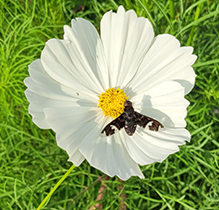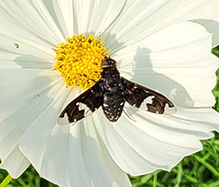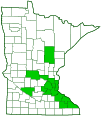adorned bee fly
(Exoprosopa decora)
Conservation • Description • Habitat • Ecology • Distribution • Taxonomy
|
|
||||||||||||||
Description |
Adorned bee fly is a medium-sized, parasitic fly. It occurs in the United States in the Northeast, the Upper Midwest, and the Great Plains. It occurs across southern Canada, but it is uncommon outside of Nova Scotia, Quebec, and Ontario. Adults are active from late June to August. They are found in meadows and at forest edges. They are usually seen on flowers or resting on the ground in open areas. The larvae are parasites of wasp larvae. Adults are stout-bodied, hairy, and ⅜″ to ⅝″ (10 to 15 mm) in length. The face is cone shaped. The antennae are shorter than the head, and they have four segments, a scape at the base, a connecting pedicel, and two flagellomeres. The first flagellomere is cone shaped. The second flagellomere is long and has a slender appendage (style) at the tip. It does not have a tuft of hairs at the tip. The rear margin of each compound eye is strongly indented. The tube-like mouthpart (proboscis) is short, extending less than the length of the antennae. The abdomen is black. The upper side is covered with a variable amount of black hairs. The sides are densely covered with soft, woolly, black hairs. White hairs are restricted to a few small spots. There are no white or orange bands. The wings are as long as the abdomen. They are mostly dark brown with clear spots. The leading edge (costal margin) is dark brown from the base to beyond the end of the subcosta (Sc) vein. The dilated portion of the marginal cell is entirely brown. The basal half of the anal cell is brown. There are three broad, dark brown, transverse bands: one at the base (basal), one before the middle (median), and one before the tip (subapical). The basal band is poorly defined. The wing tip is clear. The clear area is restricted to cell r4 and the rear (distal) part of cell r2+3. vein M1 ends behind the wing tip. vein R2+3 arises from vein R4+5 at a right angle near crossvein r-m. It has a single curve near the end, and it is connected by a crossvein to the R4 vein. The discal cell is present. |
Size |
Total length: ⅜″ to ⅝″ (10 to 15 mm) |
Similar Species |
Habitat |
Meadows and at forest edges |
Ecology |
Season |
Late June to August |
Behavior |
The wings are held stretched out when at rest. Adults do not bite. |
Life Cycle |
|
Larva Hosts |
Wasp larvae |
Adult Food |
|
Distribution |
||
|
Sources |
|
| 8/8/2025 | ||
Occurrence |
||
|
||
Taxonomy |
|
Order |
|
Suborder |
Brachycera |
Infraorder |
Orthorrhapha |
Superfamily |
Asiloidea |
Family |
Bombyliidae (bee flies) |
Subfamily |
Anthracinae |
Tribe |
Exoprosopini |
Genus |
Exoprosopa |
Subordinate Taxa |
|
|
|
Synonyms |
|
|
|
Common Names |
|
adorned bee fly |
|
Glossary
Costal margin
The leading edge of the forewing of insects.
Flagellomere
A segment of the whip-like third section of an insect antenna (flagellum).
Proboscis
The tube-like protruding mouthpart(s) of a sucking insect.
Style
On plants: Part of the pistil, usually a slender stalk, connecting the ovary to the stigma(s). On flies (Diptera): A terminal, often slender or pointed, appendage arising from the end of the last, usually third, antennal segment.
Visitor Photos |
||
Share your photo of this insect. |
||
This button not working for you? |
||
Gregory Gilman |
||
 |
 |
|
MinnesotaSeasons.com Photos |
||
|
||
|
||

Slideshows |
|

Visitor Videos |
||
Share your video of this insect. |
||
This button not working for you? |
||
|
Other Videos |
||
|

|
Created: 8/8/2025 Last Updated: © MinnesotaSeasons.com. All rights reserved. |


